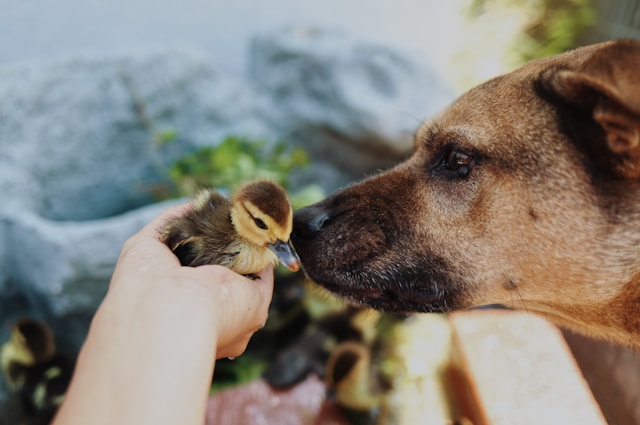Barking at the Birds: Maintaining Peace Between Dogs and birds

The joyful chirping of birds can be a beautiful addition to our outdoor spaces, but for many dog owners, it can quickly turn into a challenge. Dogs barking at birds is a common issue that can lead to stress for both pets and their feathered friends. Whether you’re a bird enthusiast or simply want a peaceful home, understanding how to manage this behavior is crucial. In this blog, we’ll explore why dogs bark at birds, share tips for maintaining harmony, and highlight some success stories of dogs and birds living together peacefully.
Understanding Why Dogs Bark at Birds
1. Instinctual Behavior
Hunting Instincts
Dogs are descendants of wolves and have inherited strong hunting instincts. When they see birds, their instinct may trigger a desire to chase or hunt, leading to barking.
2. Territorial Behavior
Protecting Their Space
Dogs are often territorial animals. If they perceive birds as intruders in their territory, they may bark to assert dominance or scare them away.
3. Excitement and Playfulness
High Energy
For some dogs, barking at birds is simply a form of play. Their excitement can lead to barking as they try to engage with the feathered creatures.
4. Fear or Anxiety
Reacting to Movement
Birds can be quick and unpredictable, which may provoke fear or anxiety in some dogs. Barking can be a response to this unease, as they try to protect themselves or their owners.
Creating a Peaceful Environment
1. Training Techniques
Basic Obedience Commands
Teaching your dog basic commands like “sit,” “stay,” and “quiet” can help you manage their behavior when they see birds. Consistent training reinforces good behavior and helps them understand what is expected.
Redirection
When your dog begins to bark at birds, redirect their attention to a toy or another activity. This helps them learn that there are more appropriate ways to expend their energy.
2. Positive Reinforcement
Reward Calm Behavior
Use treats and praise to reward your dog for calm behavior around birds. This encourages them to remain quiet and relaxed, associating the presence of birds with positive experiences.
3. Controlled Exposure
Gradual Introductions
If possible, allow your dog to observe birds from a distance without the ability to chase. This controlled exposure helps them get used to the birds without feeling the need to bark.
4. Creating a Safe Space
Designated Areas
Create designated spaces in your home or yard where your dog can feel secure and less prone to barking. A comfortable crate or designated indoor area can provide a retreat when they feel overwhelmed.
Managing the Environment
1. Bird-Friendly Spaces
Feeders and Baths
If you’re a bird enthusiast, consider placing bird feeders and baths in areas that are not directly visible from your dog’s usual resting spots. This can help minimize the chances of your dog reacting to birds.
2. Barriers and Fencing
Physical Barriers
Using fences or barriers to keep dogs away from areas where birds frequently gather can help reduce barking. This physical separation provides both pets and birds with a sense of safety.
3. Monitoring Interactions
Supervised Time
Always supervise your dog when they are outside in areas where birds are present. This allows you to intervene if barking starts, reinforcing positive behavior.
Enrichment Activities for Dogs
1. Physical Exercise
Regular Walks
Ensure your dog receives regular exercise through walks, playtime, and other physical activities. A well-exercised dog is less likely to engage in excessive barking.
2. Mental Stimulation
Interactive Toys
Provide interactive toys and puzzles to keep your dog mentally stimulated. Engaging their minds can redirect their focus from birds to problem-solving activities.
3. Training Classes
Group Training
Consider enrolling your dog in group training classes. This can enhance their socialization skills, reduce barking behavior, and create positive interactions with other pets and people.
Success Stories
1. Charlie and the Finches
The Challenge
Charlie, a spirited Labrador Retriever, loved to chase the finches in his backyard. His owners struggled with excessive barking every time he spotted them.
The Solution
By implementing positive reinforcement and training techniques, Charlie’s owners taught him to remain calm when he saw the finches. They rewarded him with treats for staying quiet and redirected his attention with toys.
The Outcome
Over time, Charlie learned to coexist with the finches. He now enjoys watching them from a distance without barking, and his owners have peace of mind knowing their feathered friends are safe.
2. Bella and the Parakeets
The Challenge
Bella, a playful Beagle, was introduced to a family of parakeets living in the home. Her excitement often led to loud barking, creating stress for both Bella and the birds.
The Solution
The family worked on desensitizing Bella to the birds by gradually introducing her to them in a controlled setting. They used a crate to allow Bella to observe without direct access to the birds and rewarded her calm behavior.
The Outcome
Now, Bella and the parakeets coexist happily. Bella has learned to respect their space, and the family enjoys peaceful evenings without barking interruptions.
Conclusion
Managing a dog’s barking at birds can be a challenging but rewarding endeavor. With understanding, training, and patience, you can create a harmonious environment for both your canine companions and feathered friends. Remember, every dog is unique, and what works for one may not work for another. Tailor your approach based on your dog’s personality and behavior, and celebrate the progress you make along the way.




